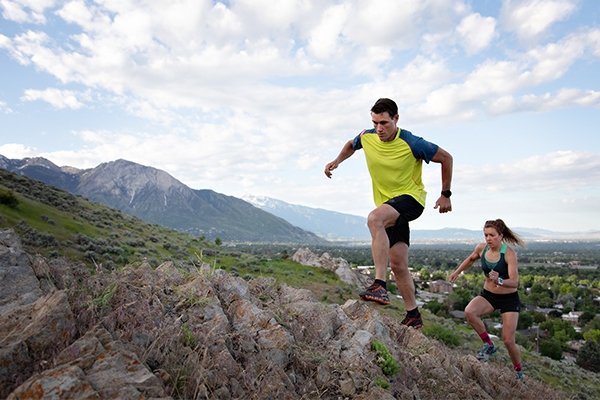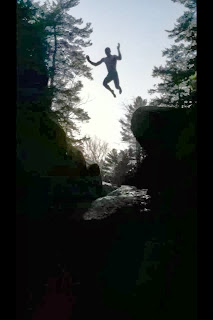For Athletes
Ankle Stability
Eversion Isometric (shown at 0:55 sec in video): These are to be performed in a pain-free manner. You can push as hard as you can tolerate provided there is no pain. Perform this exercise for 3 seconds on, 1 second off for two rounds of one minute each.
•While seated with the outside of your foot placed against something stationary (like a dumbbell), push the foot to the outside.
•Hold for 3 seconds, relax for 1 second, repeat in this way for a minute.
Single Leg Stance (shown at 1:30 in video): Standing on affected leg with a slight knee bend, try to remain standing on single leg for one minute. Repeat 3-4 rounds per side. Try these variations to increase difficulty:
•Eyes closed
•Head turns
•Unstable surface (think couch cushion)
•Eyes closed and on unstable surface
Calf Stretch (shown at 2:40 in video)
•Start by standing in front of a wall or other sturdy object.
•Step forward with one foot keeping toes on both feet pointed straight forward.
•Give a slight bend to the knee extended behind you.
•Lean forward towards the wall and support yourself with your arms as you allow your front knee to bend until a gentle stretch is felt along the back of your leg that is most behind you.
•Move the back leg further away to increase the stretch.
•Complete 3 rounds of 1 minute on each leg
For best results, the above exercises should be performed four times a week. A progression of the above routine would involve adding dynamic loading through plyometrics. I often begin with “land and stick,” which is simply hoping forward, sideways, and at an angle onto the affected limb and sticking the landing. This should be pain free. Once hoping and landing with control becomes easy, a person can add ballistic training in the form of single leg hopping up onto a step, single leg lateral hops, and forward single leg hops with the aim of spending as little time on the ground as possible. Ballistic training should have relatively low number of repetitions per set (< 30) and be followed by complete recovery before starting the next set (90 - 120 seconds recovery).
Photos and Video: © Tom Bear
***
Hamstring Strength
Heel Dig Bridge (Shown in video at 0:45 second)
•Start laying on your back; knees bent at 90 degrees.
•Dig in with heels and elevate toes.
•Squeeze buttock and raise hips, keeping tension in hamstrings via heel dig.
•Hold for a 30-60 seconds, then lower. It is importnat to remain pain free throughout the duration of the exercise.
•Repeat for 3 repetitions, 1-2 times per day.
If the above is pain free: Increase distance of heels to buttock; straighten your legs a bit; complete the Heel Dig Bridge, now with heels further out. For an increased challenge, try with one leg raised at a 45-degree angle.
Heel Dig Walk Out
•Start laying on your back; knees bent at 90 degrees
•Dig in with heels and elevate toes.
•Squeeze buttock and raise hips, keeping tension in hamstrings via heel dig.
•Keeping hips level walk heels out away from you; no need to go super low here.
•Return to the starting position. Lower. Repeat.
•3 rounds of 15 repetitions
Eccentric Hamstring Slide (shown in video at 1:45)
•Starting in bridge position with sliders under heels, lift hips up in the air.
•Slowly lower body towards ground by sliding heels away from your body.
•Keeping glutes on the ground, bring heels back to starting position
•Repeat: 3 sets of 15 repetitions.
Nordic Curl: The goal of this exercise is to control your descent towards the ground by engaging the glutes, core, and hamstrings.
•Use a rack/chair or something sturdy and stable to brace feet.
•Begin by kneeling with feet braced under chair or prop. You may use a partner to hold your feet/legs as well if available.
•Come down to the comfortable depth, push back up and repeat.
•3 rounds of 15 repetitions
Single-leg Deadlift
•While standing on one leg, bend forward while reaching toward outside of opposite foot.
•Spine should stay long, with a slight bend in stance leg.
•Touching the ground as flexibility allows
•Extend non-stance leg behind you.
•Return to the original position.
•3 rounds of 15 repetitions
As mentioned in the video, avoid the temptation to over-stretch. Tensile strength through isometrics (heel digs), progressing through movement under load (heel dig walk outs, slider lower, nordic curl), then into run specific strengthening (single leg deadlift). Making multi-angle lunges and single leg deadlifts part of a dynamic warm up before running is good for almost everybody, but if you’re prone to hamstring strains, don’t skip it.
Photos and Video: © Tom Bear
***
Proximal Hip Strength and Coordination
PT FOR MOUNTAIN RUNNERS - ANTERIOR KNEE PAIN

If you're having knee pain, look up the chain! Andrew Fast DPT shares two hip exercises for runners...
- - -
Pain while climbing stairs, after sitting too long, or while running downhill can have multiple causes. Sometimes, and often with runners, pain in the front of the knee is a result of coordination deficits and poor strength in the hip. Put differently, the better a person’s hip strength and control, the less risk of undue stress on the knee.
Two corrective exercises I often couple together are Fast Feet and Slider Sweeps. For best results, perform both exercises consecutively three times per week:
Fast Feet (shown at 0:45sec in video 30-45 reps, 2-3 sets, repeat on each side)
•With a moderate resistance band around ankles stand in front of a full-length mirror.
•Shift weight onto one leg.
•The standing leg should have a slight knee bend.
•Tap the right toe out to the side then back toward midline at a cadence similar to running.
•Maintain that slight knee bend on the standing knee the entire time.
As the raised foot steps out and resistance increases, focus on the standing knee cap in the mirror—it should not move side to side.
•Remove the ankle band and go right into Slider Sweeps
Slider Sweeps (shown at 1:38 in video;10-12 reps, 2-3 sets, repeat on each side)
•Stand on the one leg in front of a full-length mirror with the same slight knee bend as mentioned above.
•Place a furniture-mover, tupperware lid, or slider under the ball of the raised foot.
•Focusing on the standing knee cap in the mirror, perform a half circle sweep with the right leg, keeping the slider underneath the ball of your foot.
•This is finesse work, move slowly and with control.
Repeat the above sequence on the opposite leg.
Additional hip strengthening, like side lying hip abduction, single leg bridge, and lateral steps with band at ankles, are all a good supplement to the above exercises. Another potential cause for pain and tracking issues in the knee is tight hip flexors and quadriceps. Half kneeling hip flexor stretch is my go-to, holding three rounds of one minute on each side.
Photos and Video: © Tom Bear
***
Simple Core
***
US Ski Team Simple Strength with Noah Hoffman
***
Many athlete's can benefit from this progression. Those who have the most to gain are mountain athletes with reoccurring ankle instability or anterior knee pain. This is intended to be quick but challenging and a way to improve movement and coordination in effort to reduce the risk of injury.

Comments